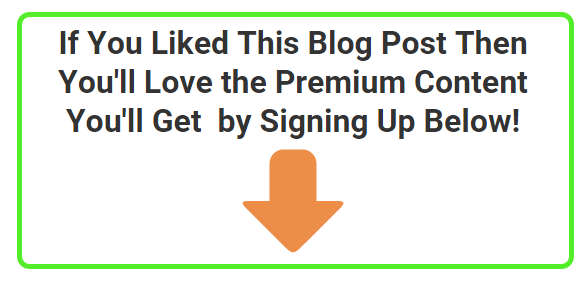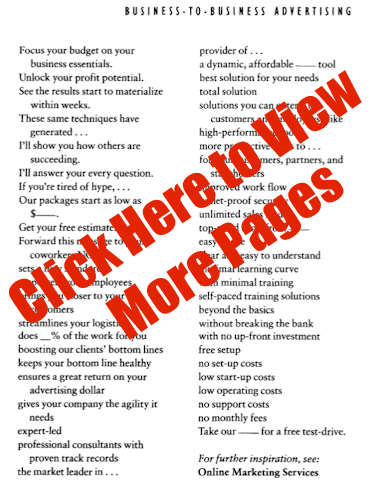You really should use these copywriting tips to keep readers on your posts.
You’ve spent scads of time writing your headlines and subheads and you know readers are going to your site.
However, for some reason, they are not reading your body copy. They’re getting bored, frustrated, and angry when they figure out that the rest of your writing sucks.
Now you’re the one frustrated and angry. You want to call your Momma and whine about your conversion rates.
What can you do?
I’ve got the solution for you right here.
Yes, there are secrets to keeping readers on your page − in this lesson I’m going to show you how to do that. If you follow a few simple rules, you can get people to read most of your copy and follow your call to action.
Learn to Write Copy as the Advertisers Do
The very first thing you need to do after your headline is to immediately engage your reader in the first paragraph.
You need to start telling them exactly what it is they need to know.
In other words: Get Right to The Point .
There are two reasons for this:
Reason 1: You don’t want to hack your readers off.
People are very impatient when they are searching for information (especially on the Internet) and they actually get mad when their time is wasted.
You’ve made a promise and now you need to cough up.
Reason 2: You don’t want to waste your time either. It’s hard enough writing material that will interest your reader, so why would you waste valuable time writing crap no one else wants to read?
You need to sell your ideas or make your points as quickly as possible in your copy.
It doesn’t matter if you’re writing a blog post or an advertisement for a vacuum cleaner; every single word you write must lead your audience to take some sort of action.
[Tweet theme=”basic-white”]It doesn’t matter if you’re writing a blog post or an advertisement for a vacuum cleaner; every single word you write must lead your audience to take some sort of action.[/Tweet]
In this post, I’m going to give you some copywriting tips that’ll help keep your readers on-page. Once you start using these simple tips you’ll learn to write much faster and better.
So, let’ get started.
Learn to Write Clearly
As I’ve stated before, you don’t want to sound like a professor; you need to keep it plain and simple. It doesn’t matter if you are writing copy for an article, blog post or introductory web page.
In other words, make it clear, not foggy.
One of my pet peeves is accounting web sites.
Here’s an example:
“XYZ Accounting provides audit, tax and advisory services and industry insight to help organizations negotiate risks and perform in today’s dynamic and challenging environments.”
Really?
In my opinion, that’s a mouthful of mush. They’re not hitting the nerve needed to move a client to action.
In contrast to the accountant copy, many of the TV ambulance-chasing lawyers are using excellent copywriters to get clients.
Here’s a simple line that almost all of them are using:
“We’ll get you the money you deserve.”
Man, that’s to the point.
An accounting firm could easily use that line or a similar one to get people to read more on their page.
So the point of an accounting firm is to help clients increase the bottom line, right?
Why not get to the point?
One of the Copywriting Tips You Shouldn’t Ignore
Any good copywriter will tell you that in order to get on the level of your reader and keep them interested, you need to write as if you were conversing.
You want to write your posts and ads in simple language that anyone can understand.
One easy way to do that is to imagine that you are speaking to the person as if he or she were sitting across a table from you.
This is what is called “across the table writing” and it works really well.
If you’ve done your research, you’ll already know what your audience or prospects are looking for in your article. It should be no problem for you to imagine what it would be like to explain to them what you want them to know.
If you can imagine the type of person you’re writing to, it will help your writing.
To give you a clear example of this, I’ll use a world-famous copywriter, Gary Halbert. (His copywriting tips are the best on the planet.) The way he structures ordering instructions is very specific. In this sales ad, the Prince of Print was explaining how to order a diet product.
Notice how he uses across the table writing to get the prospect to order a product at the end of the sales ad. (This ad was written well before the Internet, so people were sending in money orders and checks. This was much more difficult than asking a person to “click on a button” on a website to order.)
Here’s Gary Halbert’s method of “asking for the sale”:
“To order write your name and address and the words “DIET SECRET” on a piece of paper and send it with $10.00 to me – Nancy Pryor, 459 Maplewood Ave., Maplewood, New Jersey 07040. I will send your book promptly by return mail. If you have any questions, you can call me. My number is (xxx) xxx-xxxx. Checks and money orders should be made payable to me – Nancy Pryor. (It is not a good idea to send me cash).”
Now, this may sound like very simple writing, but it gets sales. There is no arguing with a sales letter or ad that can get money flowing into your bank account.
Halbert was a master at this.
You want your writing to be simple and to the point, just as if you were talking with a friend at a coffee shop.
Write Like You’re Having a Conversation
I don’t know about you, but I like to read stuff that’s easy to understand language. So you need to write just like you talk; in a simple conversational style.
People will identify with someone that can write on their level far better than someone that is trying to show how smart they are.
Consider the genius Mozart. Even though his music and talents far surpassed anyone on the planet, he knew not to write to impress but to entertain. He wrote catchy simple melodies that the common man could understand.
Who else could make a hit out of “Twinkle, Twinkle, Little Star”?
And when you hear his melodies, they stick with you the rest of your life because they are catchy and easy to remember.
When you are writing, try to remember this simple phrase:
“It’s not stupid to keep it simple…stupid!”
(No offense intended, just an easy way to remember what I’m teaching you here.)
And don’t forget to try to keep your writing personal as you do it. Instead of writing, “Please fill out the response card below and return it to us.”
You could write: “Just fill out the card and send it in.”
See?
Here’s a Conversation Checklist to Help You Write Your Blog Posts
A simple checklist for writing conversational style:
- 1. Write like you are talking across the table from a friend.
You don’t want to ditch all of the grammar rules, but if your writing sounds better without it, skip the rules.
- Use terms like I, you, we, them, they, etc. This will make it as personal as possible.
Use simple words. There are tools that you can use to make your writing simpler online ―use them.
- Try to keep it genderless if you can. Instead of writing “him” “her” “his” and other gender type terms, use the title of the person if they have one. Instead of “She represented him in court.” You could write, “The law firm represented the client in court.”
You can also switch out terms like, “him” with “her” and others just to keep it as neutral as you can.
Not to contradict my copywriting tips, but don’t get too paranoid about this. Remember, your goal is a natural conversation.
- Use contractions like you’re, we’re, they’re, etc. when you can. Try to mix it up a bit and don’t use them every single time.
- Try to use words and expressions that make your message as personal as possible. Terms like wanna, gonna, bamboozle, rip-off, hair-brained, etc.
On this last point, try to use terms that are relevant to the people or market you’re writing to. You are going to use far different terms and expressions when writing for people that are skateboarders than you would for a retirement community.
Unless you’re this guy:
Resources to Help You Write Conversational Style
There are all sorts of books on the market with great copywriting tips. Two, in particular, come to mind―Words that Sell and More Words that Sell are excellent resources for this.
These two books are written by copywriter Richard Bayan, and they are an invaluable resource to anyone that’s a blogger or copywriter.
These books are for quick reference and you can just pull them off your shelf flip through them quickly and fire out the words and phrases you need to use.
They are categorized by different situations and markets.
Break it up With Graphics and Other Stuff
When I refer to graphics, I mean anything that can be used to enhance your page.
Here’s a list that should drive the point home:
Text:
- Bold
- Italicized
- Underlined
- Bullets
- Colored Text
- Highlighted Text
- Different Fonts
- Capitalized Words
- Words in All Caps
Images:
- Small Header Images
- Info Graphics
- Demonstration Images
- Examples
- Images to Separate Sections (These need to be relevant to your subject)
Video:
- Demonstration Video
- Interesting but Relevant Video
- Educational Video
With blogging, the sky really is the limit with what you can do. I like to start out my blog posts with a funny, moving image from a site called Giphy.
Even though these are funny images, you’ll want to make sure that your image helps you make your point.
If I were writing something like this:
“You don’t want to make a point that will blind your reader and make it confusing.”
I would then use an image like this:
I would not use an image like this:
See?
It has to be relevant.
Other Important Copywriting Tips
Before you publish your material either online or off, it’s always a good idea to double-check your work.
The first thing I like to do is read my copy out loud. It’s amazing the errors and weird phrases you’ll find in your writing when you do this.
Here are a couple of things you should check after you do this.
- Check to see if your copy matches the headline. If you promise something in the headline, you should make sure that your promise is fulfilled in the body copy.
- Is it easy to read? The average person reads on the 6th-grade level. Read this post to find easy to use tools to check this: Keep Readers on Your Page
- Does it persuade? When you write a sales letter or even a blog post, you are usually trying to get someone to do something. You must create a desire for the reader to do something, even if it’s only to come back to your blog and read more.
- Make sure the post or sales letter is interesting. You can use all sorts of devices like checklists, bullets and graphics to make your points. This not only breaks up your copy, but it makes it more interesting.
You can also tell a story, ask a provocative question and talk about newsworthy subjects.
- 5. Have a call to action. Not telling your reader what they have to do to take the next step you want them to is a big mistake. If you are selling a course or tangible item, ask for the sale.
Tell them exactly what it is you want them to do. If you’re building a mailing list, offer them premium content and tell them to sign up.
Conclusion
I hope you got a lot out of these copywriting tips.
Remember,when you’re writing a sales letter or a blog post remember to keep your writing simple and conversational. Pretend you are sitting across a table from your prospect or reader telling them what you want them to know.
Don’t forget to keep your reading interesting and concise. Use graphics and other devices to break up your copy and don’t forget to include a clear call to action.
Did you like this post? Hate it? Please post an intelligent, relevant response in the area below.
Spammers will get shredded.









This post was exactly what I was looking for. I think using your advice on using Infographics on my blog can help me immensely. It seems like they would be difficult to design though.